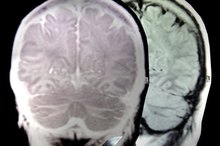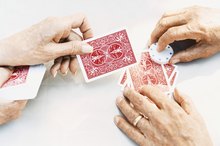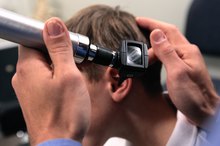Activities for Enhancing the Right Brain
The human brain is physically separated into two cerebral hemispheres. These hemispheres collaborate in cognitive functioning. For example, the brain's left side controls speech while its right side interprets language.
Typically, people utilize both sides of their brains. However, a dominant hemisphere is evident in some behaviors. If you are mathematically inclined, your left brain is dominant. If you are right-brained, you are a creative, "big picture" visionary.
You can strengthen the weaker hemisphere of your brain with exercise.
Right and Left Brain Functions
Artists and musicians tend to utilize the right cerebrum more than non-creatives. According to Eric Chudler, Ph.D., a neuroscientist and researcher at the University of Washington in Seattle, the dominant functions of the right brain are face recognition, visual imagery, spatial abilities, and music. Analytical abilities emanate from the left cerebral hemisphere.
Right Brain Builders
How to Activate Dormant Parts of Your Brain
Learn More
The right brain is the root of emotions, intuition and visualization. You can encourage your brain to explore its creative side through activities that stimulate these processes.
Since the left hemisphere of the brain is the logical, sequential side, one way to build the right side of the brain is to perform tasks "illogically." That is, break the regular pattern to which you have become accustomed. Vary your routine by dressing with your eyes closed, driving to work via a different route or moving your mouse to the "other" side of your computer's keyboard.
- The right brain is the root of emotions, intuition and visualization.
- Since the left hemisphere of the brain is the logical, sequential side, one way to build the right side of the brain is to perform tasks "illogically."
Enhancing Creativity
The rational left brain hemisphere can stop the carefree right brain hemisphere from exploring new ideas. You can re-train your brain to think outside-the-box by using methods that enhance creativity.
Contour drawing is a simple artist's exercise that develops an individual's ability to perceive "spatial" relationships--that is, how physical objects occupy visual space.
Place an object on the table in front of you. Follow the outside edges of the object with your eyes. Using a blank sheet of paper and a pencil, draw a continuous outline of the item without looking down at your paper or lifting your pencil. As you do this, notice a strong temptation to stop and examine the drawing. That is your left brain trying to make sense of a right-brained activity.
If you enjoy the game of identifying a melody by only a few notes, it is because you are allowing your creative side to take control. Playing a musical instrument "by ear" without sheet music or composing an original tune are additional methods of right brain enhancement.
- The rational left brain hemisphere can stop the carefree right brain hemisphere from exploring new ideas.
- If you enjoy the game of identifying a melody by only a few notes, it is because you are allowing your creative side to take control.
Brain Fitness
Left Frontoparietal Functions in the Brain
Learn More
Whatever your cognitive tendency, left- or right-brained deficiencies can be corrected through brain training exercises. Achieve optimal brain fitness by building a balanced creative and analytic brain.
Related Articles
References
- University of Washington: Neuroscience for Kids: Brain Imaging
- Learning Rx: Right Brain Exercises
- Corballis MC. Left brain, right brain: facts and fantasies. PLoS Biol. 2014;12(1):e1001767. doi: 10.1371/journal.pbio.1001767
- Whitehouse AJ, Bishop DV. Hemispheric division of function is the result of independent probabilistic biases. Neuropsychologia. 2009;47(8-9):1938-43. doi: 10.1016/j.neuropsychologia.2009.03.005
- Goldie J. The implications of brain lateralisation for modern general practice. Br J Gen Pract. 2016;66(642):44-5. doi: 10.3399/bjgp16X683341
- Gazzaniga MS. The split-brain: rooting consciousness in biology. Proc Natl Acad Sci USA. 2014;111(51):18093-4. doi: 10.1073/pnas.1417892111
- Shen HH. Inner workings: Discovering the split mind. Proc Natl Acad Sci USA. 2014;111(51):18097. doi: 10.1073/pnas.1422335112
- Gainotti G. Why are the right and left hemisphere conceptual representations different? Behav Neurol. 2014;2014:603134. doi: 10.1155/2014/603134
- Liederman J. The dynamics of interhemispheric collaboration and hemispheric control. Brain Cogn. 1998;36(2):193-208. doi: 10.1006/brcg.1997.0952
- Joseph R. The right cerebral hemisphere: emotion, music, visual-spatial skills, body-image, dreams, and awareness. J Clin Psychol. 1988;44(5):630-73.
- Macdonald K, Germine L, Anderson A, Christodoulou J, Mcgrath LM. Dispelling the Myth: Training in Education or Neuroscience Decreases but Does Not Eliminate Beliefs in Neuromyths. Front Psychol. 2017;8:1314. doi: 10.3389/fpsyg.2017.01314
- Nielsen, JA, Zielinski, BA, Ferguson, MA, Lainhart, JE, & Anderson, JS. An Evaluation of the Left-Brain vs. Right-Brain Hypothesis With Resting State Functional Connectivity Magnetic Resonance Imaging. PLOS One; 2013.
- Rogers, M. Researchers Debunk Myth of "Right Brain" and "Left-Brain" Personality Traits. University of Utah, Office of Public Affairs; 2013.
- National Institute of Neurological Disorders and Stroke. Brain Basics: Know Your Brain. Updated February 13,2020.
- Corballis MC. Left brain, right brain: facts and fantasies. PLoS Biol. 2014;12(1):e1001767. doi:10.1371/journal.pbio.1001767
- Demarin V, Bedeković MR, Puretić MB, Pašić MB. Arts, Brain and Cognition. Psychiatr Danub. 2016;28(4):343–348.
- Mazoyer B, Zago L, Jobard G, et al. Gaussian mixture modeling of hemispheric lateralization for language in a large sample of healthy individuals balanced for handedness. PLoS ONE. 2014;9(6):e101165. doi:10.1371/journal.pone.0101165
- Harris JE, Eng JJ. Individuals with the dominant hand affected following stroke demonstrate less impairment than those with the nondominant hand affected. Neurorehabil Neural Repair. 2006;20(3):380–389. doi:10.1177/1545968305284528
- Fridriksson J, Den ouden DB, Hillis AE, et al. Anatomy of aphasia revisited. Brain. 2018;141(3):848-862. doi:10.1093/brain/awx363
- Chen TY, Chen CY, Yen CH, et al. Acute parietal lobe infarction presenting as Gerstmann's syndrome and cognitive decline mimicking senile dementia. Neuropsychiatr Dis Treat. 2013;9:937–940. doi:10.2147/NDT.S43527
- Kiran S, Thompson CK. Neuroplasticity of Language Networks in Aphasia: Advances, Updates, and Future Challenges. Front Neurol. 2019;10:295. doi:10.3389/fneur.2019.00295
- Tippett DC, Niparko JK, Hillis AE. Aphasia: Current Concepts in Theory and Practice. J Neurol Transl Neurosci. 2014;2(1):1042.
- Schlaug G, Norton A, Marchina S, Zipse L, Wan CY. From singing to speaking: facilitating recovery from nonfluent aphasia. Future Neurol. 2010;5(5):657–665. doi:10.2217/fnl.10.44
- Hung YX, Huang PC, Chen KT, Chu WC. What Do Stroke Patients Look for in Game-Based Rehabilitation: A Survey Study. Medicine (Baltimore). 2016;95(11):e3032. doi:10.1097/MD.0000000000003032
- Mazaux JM, Lagadec T, de Sèze MP, et al. Communication activity in stroke patients with aphasia. J Rehabil Med. 2013;45(4):341–346. doi:10.2340/16501977-1122
Resources
- Edwards, B. (1999). The New Drawing on the Right Side of the Brain. NY: Penguin Putnam.
Writer Bio
Rae Casto began writing professionally in 1982. She writes on a variety of topics including health, nutrition, art and culture for various websites. Casto holds a Bachelor of Arts in psychology and art from Guilford College and a Master of Public Administration in health administration from the University of North Carolina at Pembroke.









